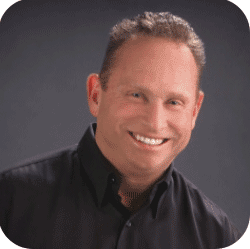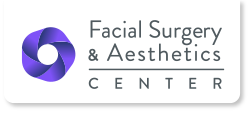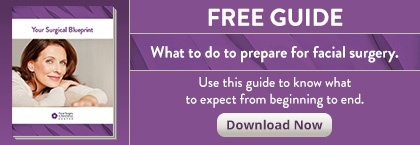
Rhinoplasty is one of the most challenging cosmetic facial surgeries because of the complicated anatomy of the nose. Even in the hands of a skilled rhinoplasty surgeon, you can experience breathing difficulties or external deformities after your rhinoplasty surgery. If this is the case, you may need a secondary rhinoplasty, called revision rhinoplasty. Revision rhinoplasty is corrective nasal surgery performed to alter the form or function of the nose after a previous nose job surgery.
Dr. Menachof, of Facial Aesthetics & Surgery Center in Denver, Colorado, knows how discouraging it can be to not get the results you were hoping for. He has performed over 4,000 rhinoplasty procedures and over 1,000 revision rhinoplasty procedures. Dr. Menachof consistently makes difficult and complicated noses look and function better than ever, and that’s why he is Colorado’s rhinoplasty expert. His patients come to Denver from all over the country for his combination of technical expertise, experience and aesthetic success. If your previous rhinoplasty results are not satisfying, schedule a consultation with Dr. Menachof today.
Do I Need Revision Rhinoplasty?
If you don’t like how your nose looks following primary rhinoplasty, or if you’re experiencing breathing difficulty after your nasal surgery, you may be a candidate for revision rhinoplasty. It is not uncommon for rhinoplasty patients to undergo a second, minor surgery to remove excess bone or cartilage. If this is the case, oftentimes the original surgeon will perform the revision rhinoplasty procedure.
However, if you have unsatisfactory results, you may want to seek a second opinion for these reasons:
- Cartilage or nasal bones have collapsed
- A noticeable defect was not addressed during primary rhinoplasty
- A defect has formed after your primary rhinoplasty (like a pinched tip or pulled-up nostrils)
- “Overdone” nose job
- Noticeable/thickened scarring
- Worsened asymmetric appearance
- Trauma to the nose
- Breathing difficulties
- Other abnormalities
How much does revision rhinoplasty cost?
The cost of rhinoplasty surgery varies based on the complexity of your procedure. Revision rhinoplasties often cost more than primary rhinoplasties because of their intricacies. Average cost of revision rhinoplasty ranges from $10,000 to $15,000. Insurance does not cover cosmetic rhinoplasty. If you are having trouble breathing through your nose because of a deviated septum, your medical insurance may cover that part of the surgery. Schedule a consultation to get an accurate estimate on your revision rhinoplasty procedure.
What is the Revision Rhinoplaty Procedure?
The first, and most important, step in your revision rhinoplasty is an extensive examination and evaluation process to determine your goals and discuss your areas of concern. Dr. Menachof recommends that you do revision rhinoplasty at least a year after your primary nose job surgery because optimal results are visible at that time.
We usually perform revision rhinoplasty under general anesthesia as an outpatient procedure. We make incisions inside or outside of the nose, and Dr. Menachof reshapes the underlying bone and cartilage. The surgery can last up to 4 hours, depending on the complexity of the particular procedure. There are two general surgical approaches to nasal surgery – open or closed rhinoplasty. Dr. Menachof will listen to your specific desires and recommend an approach that will give you the best outcome.
Step by Step the Revision Rhinoplasty Procedure
- We administer general anesthesia.
- During an open rhinoplasty procedure, Dr. Menachof makes an incision in the columella (the tissue dividing the nostrils). In a closed rhinoplasty procedure, Dr. Menachof will make an incision inside of the nose.
- This exposes underlying bone and cartilage.
- Dr. Menachof corrects the defects and, if needed, strengthens the nose through grafting.
- He restores breathing function, if necessary.
- Dr. Menachof re-drapes your skin over the nose.
- He closes the incision.
Often, cartilage grafts (portions of cartilage from the rib, ear or septum) are necessary to accomplish the goals of revision rhinoplasty because the primary procedure can deplete the original nasal cartilage. We shape these pieces of cartilage into structural pieces inside of the nose. It is vital that you choose a surgeon who has extensive experience in revision rhinoplasty and secondary techniques in order to avoid the need for further revision rhinoplasty procedures in the future.
Recovering After Corrective Rhinoplasty Surgery
Patients report that recovery after revision rhinoplasty is less painful than recovery after primary rhinoplasty. You can manage pain with medications. Some swelling and bruising will subside within 2 weeks, but it will take months for all of the bruising and swelling to disappear. Revision rhinoplasty patients typically return to work within 2 weeks, and can return to exercising by 4 weeks post-surgery. Final results are visible 6-9 months after your surgery.
I highly recommend Dr. Menachof.
I experienced him to be competent, knowledgeable, compassionate, attentive, respectful, thorough and approachable.
Susan J.
Dr. Menachof – Denver’s Best Revision Rhinoplasty Surgeon

Revision rhinoplasty is complex, and therefore the skill of your surgeon should match the demand of the procedure. Dr. Menachof is Denver’s revision rhinoplasty specialist. After performing over a thousand revision rhinoplasty procedures, Dr. Menachof has refined and perfected his rhinoplasty techniques. As an ear, nose and throat doctor, Dr. Menachof has successful outcomes with difficult nasal airway procedures. Not only will you look fantastic, your nose will function better than ever.
Make a Change Today
Don’t settle for unsatisfying results. Whether you are struggling with breathing issues or don’t like how your nose looks, Dr. Menachof can help you get the results you long for. Schedule a consultation with Dr. Menachof today to be on your way to looking and feeling more confident.
Revision Facelift: Frequently Asked Questions
If you are dissatisfied with the results of a rhinoplasty procedure, you may seek an additional surgery to fix these issues. This is called revision rhinoplasty. Between 4 and 20 percent of people who have primary rhinoplasty will have a revision rhinoplasty.
If you are dissatisfied with the form or function of your nose after a previous rhinoplasty surgery, revision rhinoplasty may be a good choice for you. Schedule a consultation with Dr. Menachof to find out what he can do to repair your botched nose job or functional issues within your nose.
Revision rhinoplasty is usually more complicated than primary rhinoplasty due to scarring in the nose, weakened bones and loss of cartilage from the original nose job surgery. The technique requires extensive care and precision, so it is important that you choose a surgeon whose skills match the demand. Make sure your surgeon has extensive experience with revision rhinoplasty and can show you pleasing before and after photos.
If you are having trouble breathing through your nose, insurance may cover some of your surgery costs. However, if you are seeking a rhinoplasty for aesthetic reasons only insurance companies do not cover the cost.
Open rhinoplasty involves incisions underneath the nose, and allows better visualization. If you have a very crooked nose or a nose that protrudes a lot, surgeons often use open rhinoplasty. Closed rhinoplasty involves incisions inside of the nose that are entirely invisible post-surgery. While there is a lot of debate about which approach is better, both have advantages. Dr. Menachof will determine the method he uses for your surgery based on your specific needs.
There are very few risks associated with revision rhinoplasty surgery when you choose an experienced rhinoplasty surgeon. Potential risks include bleeding, infection, need for more surgery, voice changes, swelling, bruising, changes in your smelling ability, breathing issues, and nasal irregularities. Talk to your surgeon about any specific concerns you may have.
During your free consultation, Dr. Menachof will examine the inside of your nose to determine if you need septoplasty to correct internal issues related to breathing. Septoplasty can correct a deviated septum or a sinus condition and help improve breathing.
Make sure your rhinoplasty surgeon has a lot of experience performing revision rhinoplasties. Rhinoplasty surgery takes close to 1,000 procedures to master the techniques. Look carefully at before and after photos of the surgeon’s past patients. Pay attention to how the new nose changes the other features of the face, and notice if the faces you see are appealing to you. Ask the surgeon about function to help determine how much experience the surgeon has treating nasal congestion issues.
Most people have very little pain following their nose surgery. Patients report that they have even less pain after a revision rhinoplasty (compared to a primary rhinoplasty). You will have a prescription for pain medication, but most patients only use it for a day or two. Nasal congestion is common for up to a week after surgery, but this does not typically cause pain.
Yes. Revision rhinoplasty before and after photos will show you a surgeon’s achievable results. Look carefully at these photos to evaluate your surgeon’s tastes and abilities and to determine if he/she can help you get the look you want.
Typically, we use a light general anesthetic for your rhinoplasty procedure. We can do most minor revision procedures with a local anesthetic and some oral sedation in the office.
Yes – swelling is a normal part of the body’s healing process. Patients report that they are less swollen and bruised after their revision rhinoplasty than their first nose job procedure.
Most people go back to work between 7 and 10 days after surgery. By that time, obvious swelling has dissipated and you can cover residual bruising with makeup.
You should experience improved breathing after your revision rhinoplasty surgery! Your facial plastic surgeon should be skilled in fixing aesthetic issues as well as inner issues with your nose.

